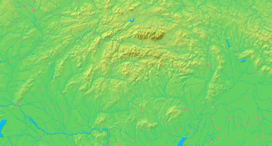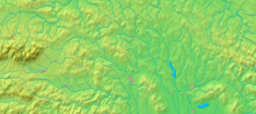Bardejov
| Bardejov | ||
| Town | ||
| The Town Hall Square (Radničné námestie) in Bardejov | ||
|
||
| Country | Slovakia | |
|---|---|---|
| Region | Prešov | |
| District | Bardejov | |
| River | Topľa | |
| Elevation | 283 m (928 ft) | |
| Coordinates | 49°17′36″N 21°16′34″E / 49.29333°N 21.27611°ECoordinates: 49°17′36″N 21°16′34″E / 49.29333°N 21.27611°E | |
| Area | 72.78 km2 (28.10 sq mi) | |
| Population | 33,020 (2010-12-31) | |
| Density | 454/km2 (1,176/sq mi) | |
| First mentioned | 1241 | |
| Timezone | CET (UTC+1) | |
| - summer (DST) | CEST (UTC+2) | |
| Postal code | 08501 | |
| Area code | +421-54 | |
| Car plate | BJ | |
| UNESCO World Heritage Site | ||
| Name | Bardejov Town Conservation Reserve | |
| Year | 2000 (#24) | |
| Number | 973 | |
| Region | Europe and North America | |
| Criteria | iii, iv | |
| IUCN category | Cultural | |
  Location in Slovakia
| ||
  Location in the Prešov Region
| ||
| Wikimedia Commons: Bardejov | ||
| Statistics: MOŠ/MIS | ||
| Website: www.e-bardejov.sk | ||

Bardejov (![]() pronunciation ; German: Bartfeld, Hungarian: Bártfa, Rusyn: Бардеёв, Polish: Bardejów[1]) is a town in North-Eastern Slovakia. It is situated in the Šariš region on a floodplain terrace of the Topľa River, in the hills of the Beskyd Mountains. It exhibits numerous cultural monuments in its completely intact medieval town center. The town is one of UNESCO's World Heritage Sites and currently maintains a population of about 30,000 inhabitants.
pronunciation ; German: Bartfeld, Hungarian: Bártfa, Rusyn: Бардеёв, Polish: Bardejów[1]) is a town in North-Eastern Slovakia. It is situated in the Šariš region on a floodplain terrace of the Topľa River, in the hills of the Beskyd Mountains. It exhibits numerous cultural monuments in its completely intact medieval town center. The town is one of UNESCO's World Heritage Sites and currently maintains a population of about 30,000 inhabitants.
Etymology
There are two theories about the origin of the name. According to one theory, the name town comes from the Hungarian word "bárd" (English: "chopper"), which indicated an amount of forested territory which could be chopped down by one man in one day. In the Hungarian name (Bártfa), the "fa" (English: "tree") suffix came later, and it also changed the last letter of "bárd" to "bárt", for easier pronunciation..
Another theory derives the name from a Christian personal name Barděj, Barduj (abbreviated forms of Bartholomew) with common Slavic possessive suffix -ov. This theory is supported by the first recorded form of the name - Bardujef (1241). The motivation by the personal name is supported also by the presence of the suffix preserved in later Polish or Slovak sources.[2]
History
The territory of present-day Bardejov has attracted settlers since the Stone Age. However, the first written reference to the town dates back to the 1240s, when monks from Bardejov complained to King Béla IV about a violation of the town’s borders by Prešov. By that time, the important church of Sv. Aegidius (St. Giles) had already been built. Heavily fortified in the 14th century, the town became a center of trade with Poland. More than 50 guilds controlled the flourishing economy. Bardejov gained the status of a royal town in 1376, later becoming a free royal town. The town’s golden age ended in the 16th century, when several wars, pandemics, and other disasters plagued the country.
Beginning in the first quarter of the 18th century, the situation began to improve. Slovaks and Hasidic Jews came into Bardejov in large numbers. By the end of the century, the population of the town had regained the level of the 16th century. The burghers' houses were rebuilt or modified in keeping with current architectural fashion. A Jewish quarter with a synagogue, slaughterhouse, and ritual baths developed in the north-western suburbs. New churches and bridges were built, as well.
Despite further fires in the last quarter of the 19th century, the town continued to thrive, thanks to major industrialization projects in the region. In 1893, a railway was opened connecting Presov to Bardejov. However, it declined again following the establishment of the first Czechoslovak Republic and became a backward farming region. World War II saw a worsening in the economic situation, though little damage from bombardment. Bardejov was taken by Soviet troops of the 1st Guards Army on 20 January 1945.
In 1950, Bardejov was declared a protected city core and extensive restoration of its cultural heritage began. These efforts culminated in Bardejov receiving the European Gold Medal by the International Board of Trustees in Hamburg in 1986 – the first town in Czechoslovakia to receive the award. On November 20, 2000, Bardejov was selected by UNESCO as one of its World Heritage Sites, recognized for its Jewish Suburbia and historic town center. In November 2010, the city marked the 10th anniversary of its inscription on the UNESCO World Heritage list.
Today, Bardejov is known mainly for its authentic old town square, which due to extensive restoration and preservation of its Medieval, Renaissance, and Gothic architecture has made Bardejov a popular tourist destination. The town draws on its rich heritage to further develop cultural traditions, such as an annual trade fair and the Roland Games (commemorating its medieval past).
Like many European small towns, Bardejov maintained a strong Jewish population before World War II and the Holocaust.
In March 2006, the Bardejov Jewish Preservation Committee was founded as a non-profit organization by Emil Fish, a survivor of Bergen-Belsen concentration camp who was born in Bardejov. In July 2005, Mr. Fish returned to Bardejov with his wife and son for the first time since 1949. His response to the disrepair and dilapidation of the synagogues and the Jewish cemetery was a resolve to restore and preserve these properties. The committee is composed of Bardejov survivors, their descendants and friends, and others interested in commemorating the vanishing Jewish communities of Eastern Europe. Today, the committee's stated mission is to: "restore the Jewish properties of Bardejov, Slovakia"; "build awareness of the cultural and historical significance of Jewish life in Bardejov and Slovakia"; and "advance knowledge of Jewish ancestry and heritage."
Landmarks
Bardejov is dominated by the monumental Church of St. Aegidius, mentioned for the first time in 1247. A three nave basilica with multiple chapels was completed in 1464. It hosts eleven precious Gothic winged altars with panel paintings. The central square (Slovak: Radničné námestie), which used to be the town’s medieval marketplace, is now surrounded by well-preserved Gothic and Renaissance burghers’ houses.
One of the most interesting buildings is the town hall, built in 1505. The lower part was built in the Gothic style, while the upper part was finished in the Renaissance style. This was the headquarters of the city council and also the center of the town's economic, social, and cultural life. In 1903, the town hall was adapted to serve as Saris Župa Museum, the oldest museum in Slovakia.
The fortification system and town walls date from the 14th and 15th centuries and are listed by the European Fund of Cultural Heritage as one of the most elaborate and best preserved medieval fortifications in Slovakia.
About 2.5 km (1.6 mi) north of Bardejov is the spa town Bardejovské Kúpele. The therapeutic mineral water springs are claimed to be beneficial to people with oncological, blood circulation, and digestive tract problems. It also hosts an open-air museum of folk architecture (skansen). The spa has played host to a number of dignitaries, including Marie Louise, Duchess of Parma (the wife of Napoleon Bonaparte), Tsar Alexander I of Russia and Empress Elisabeth of Austria-Hungary.[3]
Boroughs
The town consists of the following boroughs:
- Bardejov
- Bardejovská Nová Ves
- Bardejovská Zábava
- Bardejovské Kúpele (local spa town)
- Dlhá Lúka (annexed in 1971)
- Mihaľov
Demographics
Bardejov has a population of 33,020 (as of December 31, 2010). According to the 2001 census, 91.3% of inhabitants were Slovaks, 2.6% Romani, 2.5% Rusyns, and 1.4% Ukrainians. The religious make-up was 63.2% Roman Catholics, 16.9% Greek Catholics, 7.6% Lutherans and 4.3% Eastern Orthodox.[4]
Twin towns – sister cities
Bardejov is twinned with:
See also
References
- ↑ Komisja Standaryzacji Nazw Geograficznych poza Granicami Rzeczypospolitej Polskiej.
- ↑ Štefánik, Martin; Lukačka, Ján, eds. (2010). Lexikón stredovekých miest na Slovensku [Lexicon of Medieval Towns in Slovakia] (PDF) (in Slovak and English). Bratislava: Historický ústav SAV. pp. 79, 97. ISBN 978-80-89396-11-5.
- ↑ "Spa of Bardejov". webcache.googleusercontent.com. Retrieved 2009-05-22.
- ↑ "Municipal Statistics". Statistical Office of the Slovak republic. Archived from the original on 2007-04-27. Retrieved 2007-05-03.
- ↑ "Miasta partnerskie – Zamość". Urząd Miasta Zamość (in Polish). Retrieved 2013-07-26.
Genealogical resources
The records for genealogical research are available at the state archive "Statny Archiv in Presov, Slovakia"
- Roman Catholic church records (births/marriages/deaths): 1671–1899 (parish A)
- Greek Catholic church records (births/marriages/deaths): 1753–1906 (parish B)
- Lutheran church records (births/marriages/deaths): 1592–1896 (parish A)
External links
| Wikimedia Commons has media related to Bardejov. |
- Official website
- Info website
- UNESCO site about Bardejov
- Organization of World Heritage Cities: Bardejov
- Surnames of living people in Bardejov
